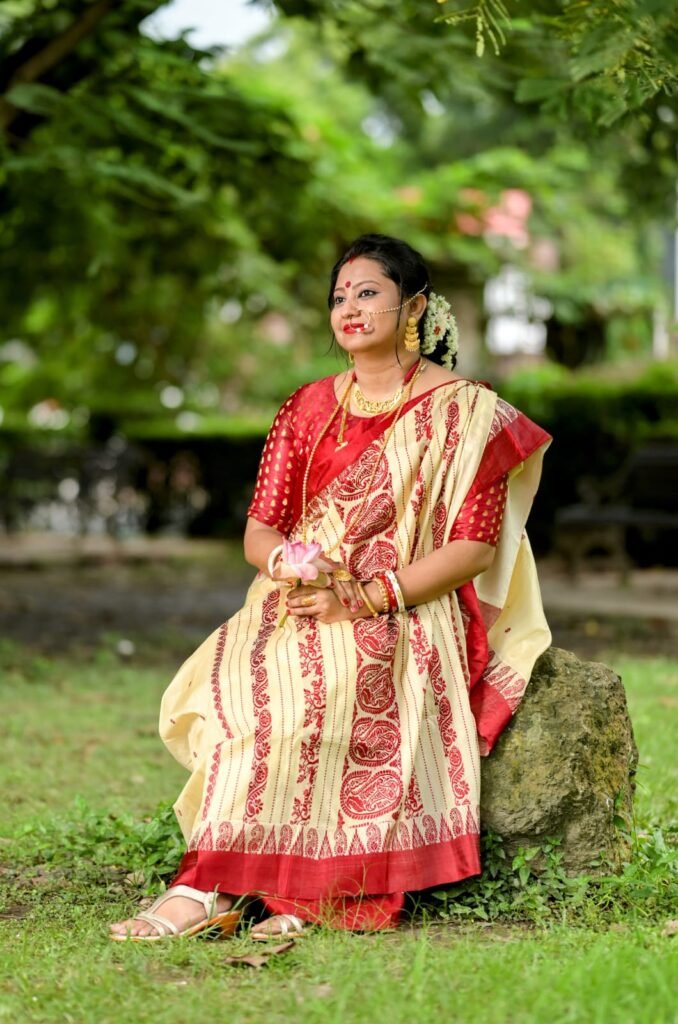The Tryst with the ‘Laal Paad Shaada’ Sari
Every Bengali woman boasts of a typical ‘Laal Paad Shaada’ (Red border white base) sari. A traditional wear, it has its roots in history and culture.
There are no clear theories behind the emergence of the red and white code. But it’s assumed that during the Zamindari rule, the womenfolk wore broad red border saris. The base was usually coloured for the younger woman and white for the older women but the red border was a constant. It was almost like a uniform.
In earlier times, since women got married early and often became widows at a tender age, all households had two sets of women, the widows and the married, clearly distinguished by the colour code. Saris were made from a white cloth, better known ‘thaan’ in Bengali. While the widows wore white, the married women had a red border.
The colour code was nothing but, a distinguishing feature! The bright red stood for fertility, desirability and auspiciousness. A married woman also sported the red vermillion, red bangles known as pola, the red alta that adorned her feet and a big red bindi. While younger married women wore coloured base with a red border, older married women shifted to white base with a red border.

There is also a historical background. Years ago, when Netaji Subhash Chandra Bose formed the INA, the women wore Red and White. A progressive leader of those times, he chose to highlight the mission through these colours. While white signifies purity and peace, red – the colour of blood, is the sign of spirit, passion, energy and confidence. This code was a mark of protest. Scores of women in red and white spoke for the power and ferocity of their mission. I have observed the ‘Laal Paad Shaada’ culture in my family for years.
My earliest memory is of my maternal grandmother, collecting Parijat flowers in a glass bowl. As she walked down the stairs in our ancestral house, the pallu of her red and white Gorod sari trailed behind her.
My paternal grandmother was a vision in red. A huge red bindi, Vermillion-filled middle parting, wrists laden with Shankha and Pola, feet coloured in red with Alta, and a broad red-border white sari.
Fast-forwarding to the seventies, every Thursday, my mother would step out from the changing room in a crisp white sari with a red border. It was always a Tangail from Bengal’s Fulia district. She would sit on the floor and make Bhog for Goddess Lakshmi.
The white and red border sari has always been associated with worship and rituals. Deemed auspicious, it was worn only by married women. Unmarried women or widows were barred from sporting this code.
All these three women in my family underwent a drastic transformation when they lost their spouses. When my paternal grandfather died, my grandmother stepped out of her room in a stark white sari. The bindi had been scrubbed off leaving a white circular spot on her broad forehead. The bangles were all gone except for a golden one.
My maternal grandmother also took to white after my grandfather’s passage. This year in January, I lost my father. Ma gave up her reds, oranges and all bright colours. Even though the times have changed, my mother feels that these colours are meaningless without her husband’s presence.
The red and white code is almost a right endowed to women by virtue of marriage. With the death of the husband, this right automatically stands withdrawn. Red is also the symbol of marital bliss. But to me, it’s a subtle tool of oppression exercised by the patriarchal society. If a married woman dies before her husband, she departs regally dressed in red and white. Leaving behind her husband is a much-coveted honour but leaving after her husband is not! She is branded as a ‘husband-eater.’ White is thus, a punishment for her.

This Pujo, let’s wear ‘laal paad shaada’ to pay respect to the women who wore it as a sign of revolt.
This Pujo, let’s wear it to break the patriarchal code.
This year, uphold the fervour of patriotism and not patriarchy. Let’s celebrate the indomitable spirit of a woman and fly high!

By Sreemati Sen
Sreemati Sen holds a Masters in Social Work from Shantiniketan. A Development Professional,
she has specialized in Psychiatric Care of Differently-abled children. Years of experience in
Social and Consumer Research are also a part of her portfolio. Her stories have been featured in
various anthologies.
She can be contacted at Sreemati123p@gmail.com.














